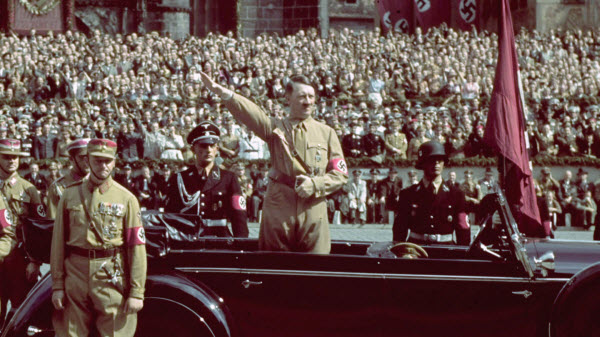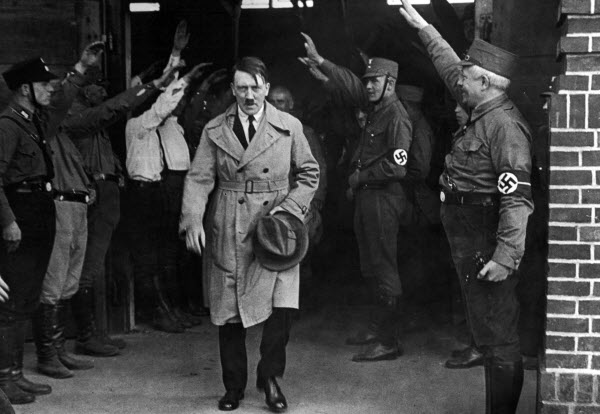Adolf Hitler remains one of the most significant figures in history, having profoundly altered the course of world events. His policies led to the outbreak of one of the most brutal wars in history, resulting in the death, injury, and displacement of millions of people—either during the battles or within extermination camps built on racial ideology. Hitler’s advocacy for Aryan supremacy and the purity of the Aryan race over other peoples has made him the central figure of countless books, documentaries, and television programs.

Early Life
Born on April 20, 1889, in Braunau am Inn, Austria, Adolf Hitler was the fourth of six children in a family led by his father, Alois Hitler, and mother, Klara Pölzl. During his childhood, he often clashed with his emotionally harsh father, who disapproved of his son’s passion for art and refusal to pursue a career in the fine arts. Hitler showed an early interest in German nationalism, which would become the driving force behind his later leadership. In 1903, his father died, and two years later, his mother allowed him to leave school. After her death in 1907, the young Hitler moved to Vienna to work as a watercolor painter. He applied twice to the Academy of Fine Arts but was rejected on both occasions. With little money, he lived in homeless shelters and later claimed that these years fostered his anti-Semitic views. By 1913, he had moved to Munich, and with the outbreak of World War I, he volunteered for the German army and was accepted in August 1914, despite still being an Austrian citizen.

Although Hitler spent most of his time away from the front lines, he was present at several important battles and was injured at the Battle of the Somme. He was honored for his bravery, receiving the Iron Cross First Class and the Black Wound Badge. The war significantly bolstered his sense of German nationalism, but he was shocked by Germany’s surrender in 1918. Like many nationalists, he believed that the German army had been betrayed by civilian leaders and Marxists. He found the Treaty of Versailles humiliating, particularly its terms for disarming the Rhineland and the responsibility Germany bore for the war.

Rise with the Nazi Party
After World War I, Hitler returned to Munich and continued working with the German army as an intelligence officer, where he monitored the activities of the German Workers’ Party (DAP), which at the time espoused many anti-Semitic and anti-Marxist ideas under its founder Anton Drexler. In September 1919, Hitler joined the DAP, which later changed its name to the National Socialist German Workers’ Party (Nazi Party). Hitler designed the party’s emblem, featuring a swastika in a white circle on a red background. He quickly gained notoriety for his fiery speeches against the Treaty of Versailles, rival politicians, Marxists, and Jews. In 1921, Hitler replaced Drexler as the party’s leader. His impassioned speeches began to attract large crowds, including early followers like Captain Ernst Röhm, head of the SA, a paramilitary wing of the party responsible for protecting meetings and attacking political opponents.

On November 8, 1923, Hitler and his armed followers stormed a public meeting in Munich where Bavarian Prime Minister Gustav von Kahr was present. He announced the beginning of a national revolution and the formation of a new government. After a brief struggle that resulted in several deaths, the coup, known as the Beer Hall Putsch, failed. Hitler was arrested and tried for treason, receiving a nine-month prison sentence during which he wrote his autobiography and his ideas in “Mein Kampf.” The first volume was published in 1925, and the second in 1927. Despite its logical flaws and grammatical errors, many Germans were drawn to the book, particularly after feeling wronged by their defeat in World War I.
Ascension to Power
The widespread unemployment caused by the Great Depression provided a golden political opportunity for Hitler. Germans’ aversion to the parliamentary republic made them increasingly open to extremist options. In 1932, Hitler ran for president against 84-year-old Paul von Hindenburg, coming second in both rounds of voting but gaining over 36% of the final votes. The results demonstrated that Hitler had become a significant force in German politics, compelling Hindenburg to reluctantly appoint him Chancellor to stabilize the political balance. Hitler used his position to establish a de facto legal dictatorship, especially after issuing a decree following the Reichstag Fire, which suspended basic rights and allowed detention without trial. He also designed the Enabling Act, granting his government full legislative powers for four years and permitting deviations from the constitution. Together with his political allies, Hitler achieved complete control over both the legislative and executive branches of government while systematically suppressing remaining political opposition. By the end of June, other parties were intimidated into submission, and on July 14, 1933, the Nazi Party was declared the only legal political party in Germany. In October of that year, Hitler ordered Germany’s withdrawal from the League of Nations. The day before Hindenburg’s death in August 1934, the cabinet passed a law abolishing the presidency and combining its powers with those of the Chancellor, making Hitler both Head of State and Government as well as Commander-in-Chief of the armed forces.

Anti-Jewish Policies
From 1933 until the war began in 1939, Hitler and the Nazi regime enacted hundreds of laws and regulations to restrict and exclude Jews from society, fulfilling the Nazis’ promise of persecution. On April 1, 1933, Hitler implemented a nationwide boycott of Jewish businesses, followed a week later by the “Law for the Restoration of the Professional Civil Service,” which excluded Jews from civil service, implementing Aryan ideas that called for their exclusion along with non-Aryans from organizations and jobs. This extended to all aspects of public life, limiting the number of Jewish students in schools and universities, restricting their work in medical and legal professions, and prohibiting Jewish performers from appearing in cinema or theater. The Reich Main Office for Press and Propaganda urged German students to “act against un-German spirit,” leading them to burn over 25,000 “un-German” books, marking the beginning of a new era of Nazi censorship and propaganda.

On September 15, 1935, the Reichstag introduced the Nuremberg Laws, which defined a Jew as anyone with three or four Jewish grandparents, regardless of self-identification or religion. The laws also included the “Protection of German Blood and Honor,” which prohibited marriage between non-Jewish Germans and Jews, and the Reich Citizenship Law, which deprived non-Aryans of German citizenship benefits. By 1936, Hitler and his regime softened their inflammatory rhetoric and racist actions while hosting the Winter and Summer Olympics to avoid international criticism and negative impacts on tourism. After the Games, the racist rhetoric resumed, including the expulsion of Jewish workers, exclusion from public schools, universities, theaters, and sports events, and a prohibition on Jewish doctors treating “Aryan” patients. Jewish passports were stamped with a “J” for “Jew.”
On November 9-10, 1938, a wave of violence against Jews swept across Germany, Austria, and parts of Sudetenland. Nazis destroyed synagogues, vandalized homes, schools, and businesses, killing about 100 Jews. The event, known as Kristallnacht or “The Night of Broken Glass,” left behind shattered windows from the destruction. Subsequently, around 30,000 Jewish men were arrested and sent to detention camps.
Social Policies
Hitler’s policies targeted children with physical and developmental disabilities and authorized a euthanasia program for disabled adults to “improve” the race. He also targeted homosexuals, arresting about 100,000 men from 1933 to 1945, some of whom were imprisoned or sent to concentration camps, where they were forced to wear pink triangles to signify their sexuality, which the Nazis considered a crime and illness. Hitler encouraged Germans to maintain pure bodies free from intoxicants and promoted anti-smoking campaigns nationwide.
In 1938, Hitler signed the Munich Agreement with several other European leaders, conceding the Sudetenland to Germany, partially overturning the Treaty of Versailles. This diplomatic victory earned Hitler the title of Time magazine’s Man of the Year for 1938, which fueled his appetite for renewed German dominance. On September 1, 1939, Germany invaded Poland, prompting Britain and France to declare war on Germany two days later. In 1940, Hitler escalated military activities by invading Norway, Denmark, France, Luxembourg, the Netherlands, and Belgium, and by July, ordered bombings of the United Kingdom in an attempt to conquer it.

During World War II, Germany formally allied with Japan and Italy, known as the Axis Powers, in late September to deter the United States from supporting Britain and its allies. On June 22, 1941, Hitler violated the non-aggression pact with Joseph Stalin by sending a massive German army into the Soviet Union, capturing vast territories before temporarily halting the invasion to encircle Leningrad and Kyiv. This allowed the Red Army to regroup and launch a successful counteroffensive, stopping the Germans outside Moscow in December 1941. The same month, Japan attacked Pearl Harbor, prompting Hitler to declare war on the United States and the Allies, which included Britain, the world’s largest empire led by Prime Minister Winston Churchill; the United States, the world’s largest financial power led by President Franklin Roosevelt; and the Soviet Union, with the world’s largest army led by Joseph Stalin.
Despite early successes, Germany soon faced failures. By late 1942, German forces failed to capture the Suez Canal and lost the Battle of El Alamein, resulting in the loss of control over North Africa. The German army also suffered defeats at Stalingrad, marking a turning point in the war, and Kursk, the largest tank battle in history. In 1943, German forces were driven from Tunisia and Italy, and their advance into Soviet territory was halted. In May 1944, Allied forces landed in Normandy, France, and the subsequent push into German-occupied Europe began. Hitler’s forces faced intensified Soviet attacks on the Eastern Front, with Soviet troops reaching Berlin in April 1945. Hitler and Eva Braun, his long-time companion, married on April 29, 1945, and committed suicide the following day in their bunker.
Legacy
The Holocaust, during which approximately six million Jews were exterminated, remains one of the most horrific outcomes of Nazi policy. The war caused unprecedented destruction and led to the deaths of millions of civilians and soldiers. In addition to Jewish victims, Nazi policies targeted Romani people, disabled individuals, homosexuals, political dissidents, and other minorities. Hitler’s aggressive expansionist policies resulted in immense human suffering and geopolitical upheaval, significantly influencing the post-war world order and leading to the formation of the United Nations.
